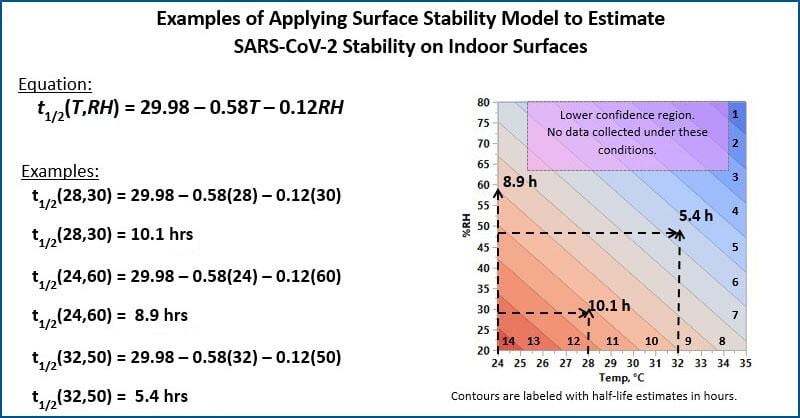The Department of Homeland Security (DHS) Science and Technology Directorate (S&T) has released a predictive modeling tool to estimate natural decay of SARS-CoV-2 (the virus that causes COVID-19) under a range of temperatures and relative humidity. Leveraging the results of research being conducted at S&T’s National Biodefense Analysis and Countermeasures Center (NBACC), the tool is designed to assist response efforts and estimate the environmental persistence of the virus under certain combinations of temperatures and humidity.
“While researchers across the federal government and the medical community continue to study COVID-19, preventing the spread of the virus is a top priority,” said William N. Bryan, DHS Senior Official Performing the Duties of the Under Secretary for Science and Technology. “Transmission occurs primarily through respiratory droplets produced by talking, coughing, and sneezing. If these droplets settle on surfaces or objects, contact with those contaminated surfaces may also be a factor in spreading the virus.”

S&T’s studies show that the virus can survive in droplets of saliva on surfaces for extended periods of time, depending on temperature and relative humidity. Using this data, S&T developed a predictive model to estimate virus decay under a limited range of conditions representative of indoor environments. This initial version of the model includes room temperatures ranging from 70 to 95 degrees Fahrenheit and relative humidity ranging from 20 to 60 percent.
Background
- Preventing person-to-person spread of SARS-CoV-2 is the only means to reduce the impact of COVID-19 in the absence of an effective therapeutic.
- Transmission occurs primarily through respiratory droplets produced by talking, coughing, & sneezing.
- Contact with contaminated surfaces & objects may also contribute to spread.
- SARS-CoV-2 will survive in saliva and respiratory fluids on surfaces for extended periods of time under certain conditions.
- DHS S&T has studied the stability of SARS-CoV-2 in simulated saliva, using droplets of varying size deposited on a non-porous surface under a range of temperature and RH conditions.
- Viral survival on surfaces is driven by temperature, relative humidity (RH), and matrix (e.g., bodily fluids).
- These data have been used to develop a predictive model to estimate virus decay under a limited range of environmental conditions.
- Testing performed on non-porous surfaces, specifically stainless steel, ABS plastic, and nitrile rubber (coming soon).
- There was no significant difference found in the decay of the virus found between stainless steel and ABS plastic.
Model Caveats
- Infectious dose is unknown (how much makes a person sick)
- Virus shedding is unknown (how much a sick person puts into the environment)
- Contact Hazard (how much virus comes off from touching surfaces)
- Model can estimate virus decay at certain conditions: temperature (room temperature or 70°F to 95°F) and relative humidity from 20-60%, without exposure to direct sunlight.
This model will continue to be enhanced as DHS S&T produces additional data for virus stability in different environments (e.g., droplets in the air vs. on a surface, expanded temperature and humidity ranges, different surfaces).
This research is being conducted as part of S&T’s Probabilistic Analysis for National Threats Hazards and Risks (PANTHR) program.
Source: DHS


